by Naomi | Dec 23, 2014 | Creative Life
 A few years ago, I made a decision that changed my life. Even though I had a BFA in Theatre Arts and was pursuing an MFA in Writing for Children, I felt like someone pretending to be an artist. All around me, highly creative people produced inspired work. I was the ugly step-sister craftsperson. I worked hard, sure, but I was also too careful, too structured. While my work was adequate, lightning wasn’t striking.
A few years ago, I made a decision that changed my life. Even though I had a BFA in Theatre Arts and was pursuing an MFA in Writing for Children, I felt like someone pretending to be an artist. All around me, highly creative people produced inspired work. I was the ugly step-sister craftsperson. I worked hard, sure, but I was also too careful, too structured. While my work was adequate, lightning wasn’t striking.
I’d hit my natural ceiling. Without drastic action, I wasn’t going to grow. The moment that actually pushed me over the edge was an editor reading my manuscript and telling me, “You’re not writing what you need to be writing. This story is well-written, sure, but you–you’re not in here.”
Why was being an artist so important to me? To me, living life as an artist meant risking asking the big questions. It meant stretching to my outer limits and beyond. It meant seeking truth in the hopes of shining light for others. My role models, Madeleine L’Engle and C.S. Lewis, had both done this with their work. Their fiction and nonfiction had reached out of the pages of their books and challenged me to live a bigger, a more meaningful, life. No one could guarantee that my work would have this significance, I knew. However, if I only dipped my toe into the creative ocean and never dared to dive in, well… my work would never have more than toe-dip impact.
At the time, I was writing my creative thesis on the importance of play in the creative process. I’d been approaching this task intellectually, squishing every last bit of fun out of my play. I was trying to force myself to act like an artist, all the time becoming less and less inspired. So, I wrote to my graduate advisor and announced, “I’m going to write a play, a hero’s journey, about my process of learning how to play. I’m going to start now.”
 She responded: “Cool!” and then, “Are you sure it will work?” I wasn’t, to be honest. But I assured her it would. In the end, committing to the process was what made it work. I wrote the play and produced it. Through the process of journaling, shaping the story, rehearsing with the cast, creating costumes, sets and choreography, composing music, and learning how to edit video, I battled some of my deepest challenges: perfectionism, the need for control, and the search for my unique voice in the sea of creative voices in the world, to name a sampling.
She responded: “Cool!” and then, “Are you sure it will work?” I wasn’t, to be honest. But I assured her it would. In the end, committing to the process was what made it work. I wrote the play and produced it. Through the process of journaling, shaping the story, rehearsing with the cast, creating costumes, sets and choreography, composing music, and learning how to edit video, I battled some of my deepest challenges: perfectionism, the need for control, and the search for my unique voice in the sea of creative voices in the world, to name a sampling.
After the play ended, though, I felt at odds. I’d been engaging with life in a new way, but after we finished the production, I slipped back into life as usual. My old habits returned, stomping down those fresh shoots of artistry that had started to sprout.
Fast forward to December 2014. My inbox was being bombarded with offerings of goal-setting courses and books. I watched some of the videos and listened to two very insightful books, The One Thing by Gary Keller and Essentialism by Greg McKeown. I went through Donald Miller’s Creating Your Life Plan. As pieces fell in place, I realized I needed a practice that combined the inner work I needed to do with my outer goals, work and otherwise. We are not simply what we do, but what we focus our energy on day in and day out can’t help but affect who we become.
What I needed was a new hero’s journey. So, I made another decision. I decided to try a hero’s journey experiment this year. I’m going to share some thoughts along the way here, on my blog, because I know a travelogue can often help a traveler experience sights and experiences on a deeper level. Perhaps my travels will inspire you to ask a new question or to try an experiment of your own. We’ll see what happens together.
Here’s how I’m setting out.
 I put together a journal in which I reviewed key successes from last year, as well as habits and thinking I need to let go. I added pages where I can map out the journey and take notes along the way for each stage. One tool I knew I’d need was a symbol to help me transition from stage to stage. I bought small coins, and plan to drop each into a fountain or wishing well as I say goodbye to one stage and hello to the next. Also, to keep myself open to the possibilities, I’m collecting one thought per day in my hero’s journey book. For instance, when I’m Listening for the Call, I’ll write down one word or phrase per day. Then, when I come to the end of the month and am ready to Cross the Threshold, I can review the cards to see what pattern emerges from the sum of those days.
I put together a journal in which I reviewed key successes from last year, as well as habits and thinking I need to let go. I added pages where I can map out the journey and take notes along the way for each stage. One tool I knew I’d need was a symbol to help me transition from stage to stage. I bought small coins, and plan to drop each into a fountain or wishing well as I say goodbye to one stage and hello to the next. Also, to keep myself open to the possibilities, I’m collecting one thought per day in my hero’s journey book. For instance, when I’m Listening for the Call, I’ll write down one word or phrase per day. Then, when I come to the end of the month and am ready to Cross the Threshold, I can review the cards to see what pattern emerges from the sum of those days.
I started, of course, with Ordinary Life. What does that mean? I’ve been working on noticing where I am, right here and now. I’ve been organizing and decluttering my spaces, making room for whatever might be coming next. Another focus has been on building healthy habits such as exercise and blocking off regular time for writing. I’ve been practicing saying no, when appropriate.
I’m planning on tossing my first coin into a fountain around January 1. Then, it will be time to start Listening for the Call. I can’t help but believe that something extraordinary might show up. In any case, I know that by committing to the journey, I am engaging with life. I’m living the artist’s life.
by Naomi | Jul 15, 2014 | Creative Life
 I just read a post by Michael Hyatt about the way that balance feels. You should read it, too.
I just read a post by Michael Hyatt about the way that balance feels. You should read it, too.
Michael wrote that when one is balancing on a rope, one doesn’t feel balanced. Instead, one is constantly noticing what is off-balance and adjusting. When I read his words, my stomach did that strange swoop thing it does when I’m walking on any narrow object. Yes, I thought. Absolutely. No wonder the very people who intentionally seek balance always feel off-course. The only way to stay balanced to be aware of what’s out of balance. I’ve written frequently about finding balance through adjusting expectations. When we have a realistic picture of our lives, grounded in the facts of our given circumstances, only then can we make needed adjustments.
Last weekend, I spent time with alumni from Hamline’s MFA program. The question came up: How do writers find a work-life balance? For writers, finding balance is particularly hard. We are passionate about sitting down at the page and setting down words. We must do this for our mental and spiritual health. Yet, writing is such a quiet, personal thing, that it can appear like doing nothing. Sometimes the people in our life point this fact out, asking us to drive them to the airport or help pack for a move instead. For me, though, the biggest obstacle is myself. Daily, I struggle to remember that my writing is important, that it matters, and that giving myself the time to write isn’t selfish. I’m giving myself time to be me. Wouldn’t I passionately defend such time for anyone else?
So, here is the reality. We aren’t finding balance. We are actively balancing. It’s a verb, not a noun, and one one that evokes a visceral, gut-level sensation. Balancing isn’t a warm glow the way happiness is–That’s where we run into trouble. We expect balance to feel soft and airy, the way one might feel after an intense yoga session. Balance is a jolt, a shock of electricity, an instinctual reaction built into our DNA. We may long for balance that feels calm and settled, but instead, we must adjust our expectations. Balance is aware of itself. It is an ongoing, active process, full of experimentation, strategy and practice.
What if instead of asking, “How do I find a work-life balance?” we asked, “Where am I leaning too heavily? What adjustments might I make to right myself today?” The more specific the answers, I think, the better. No need to be overly ambitious about fixing one’s whole life. Tomorrow, we may be out of balance in a completely other way. This task is one that can’t be checked off the to-do list. We must engage in balance every day.
Balance is individual, but in the same way that stories deal in specifics, the particulars of others’ solutions can clear our own murky waters. So, what are you doing today to adjust and find balance? I’d love to hear your thoughts below.
photo credit: Jeff Pang via photopin cc
by Naomi | Sep 4, 2013 | Creative Life
A huge thank you to Marsha Qualey, one of my Hamline Creative Writing MFA faculty, for inviting me to this blog hop! I enjoyed thinking about these four questions and the opportunity to peek inside the writing process of my author-friends. And speaking of author-friends, don’t miss the three talented authors I’ve featured at the end of this post!
And without further ado, a little Q and A…
Q: What are you working on right now?
A: I’ve just dipped my toes into the water of writing a new novel which is so new that it doesn’t even have a working title yet. I’m revisiting characters from a work I recently completed titled Reflecting Hours. I’m in the stage of writing where I’m not even trying to write scenes in sequential order yet, instead simply accumulating scenes in order to hear the voice of the story. Soon, very soon, I need to take the plunge and dive into the deep water of the book, but for now, I’m giving the creative process space and giving myself room to play. It’s an interesting creative tension, the drive to finish a book and the need to enjoy the journey. One important lesson I learned through the process of writing and publishing the four-book From Sadie’s Sketchbook series is that to be a working author, one needs to take joy in every stage of creation, not just in the moment when one holds a finished book in one’s hands. Those moments do come, but the reality of being an author is that when you finish a book, the process starts over again. The beginnings of a book whispers to you, and you start to scribble it down on whatever paper you can find, until after weeks and possibly months, you have a draft to revise and polish and reshape. One of the most essential tasks of being an author is finding one’s rhythm, and I feel like even more than working on a book right now, I’m working on that even more important task of shaping my life as an author. Im working on finding a workable pace that will allow me to grow and develop with the writing of each new book, while still finishing the process in a reasonable amount of time.
Q: How does it differ from other books in the genre?
A: Reflecting Hours and it’s untitled sequel are what I’m calling “Chem-Punk.” Similar to Steam Punk, the books are set in an alternate reality where science has progressed differently than it has in our world. However instead of relying on steam power, the world of Reflecting Hours is built on advances made through chemical technology with deep roots in alchemy. The line between technology and magic has always been thin, being that one generation’s magic is another generation’s invention. Such is the case in these books. Magic clashes against science and Elixia, who has magical abilities she doesn’t fully understand, is faced with impossible decisions that have no simple answers.
Q: Why do you write what you do?
A: When I first started writing, I thought I’d only ever write fantasy. My writing heroes are Madeleine L’Engle and C.S. Lewis, and my bookshelves are stuffed with Cornelia Funke, Anne Ursu, Edward Eager, and Susan Cooper. However, I also have a full set of the Anne of Green Gables books, and many other books that explore the magic in real life by authors such as Sharon Creech, Shannon Hale, Kate DiCamillo, and E. L. Konigsburg. What I discovered as I learned the craft of being a writer, is that what I really want to do is explore the space between real and magic, those thin places where we ask, “Is it possible that…?” For me, life is fuller, deeper, more adventurous, when the answer to that question is, “Maybe so.”
Q: What is the hardest part about writing?
A: For me, the hardest part about writing is the hardest part about being an artist, or maybe even about being human. It seems like my whole life has conspired to slam me up against the truth: you can’t grow unless you’re willing to fail. Actually, you don’t only have to be willing; you have to truly fail sometimes, too. You don’t aim to fail, of course, but you take risks that put you in a position where you aren’t sure you can succeed. Sometimes you succeed at the new challenge and you grow at a steady, predictable pace. But sometimes you fail, and how you handle the failure is the crucible for exponential growth. For a person like me, a down-to-the-bones perfectionist, even the possibility of failure (particularly public failure) brings with it heart-thumping terror of a kind that should be reserved for giant spiders, tight enclosed spaces and things that go bump in the night. When we write, we put our hearts on the page with as much skill as we can. Despite our efforts, sometimes we don’t communicate what we’d hoped to say. Other times, we say exactly what we meant, and we rile others up. Sometimes the story that we see is on a far-away vista that our current skill can’t help us to reach. Most failures are much smaller, though, the daily moments when I read the words I wrote yesterday and I have to admit: I can do better. These private, small moments are the ones in which I build the muscles I need to become the kind of writer (and person) I long to be. I want to be a person who looks at my efforts and says, “I did my best yesterday, and now, today, I’m going to do even better. It’s okay that I’m not perfect the first or fourth or twentieth time. I’m growing and learning and becoming who I’m meant to be.” This kind of thing is much easier to say than to do, and I’d never want to become the kind of person who gave in to being adequate. It’s not that we shouldn’t dream big or aim high. We should. And because we do dream big and aim high, we won’t always get it right the first time. The important thing is what we do when we see that we’ve fallen short. Will we get up and try again? Getting up, trying again, that’s the hardest part of writing for me.
And now, drumroll please… here are those three amazing authors I was telling you about. All of these lovely ladies are celebrating upcoming book releases!
First, Erin Dealey, whose book, DECK THE WALLS, A WACKY CHRISTMAS CAROL is coming out this September. This picture book is for the whole family and celebrates the joy of family and tradition and fun.
Second, Sue Fliess, whose picture book ROBOTS, ROBOTS EVERYWHERE (can you guess what it’s about??) has just hit the shelves.
Third, Holly Schindler, whose THE JUNCTION OF SUNSHINE AND LUCKY for middle grade readers is scheduled to launch in February 2014.
I hope you’ll visit their blogs and check out their books! And if you’d like, I’d love to hear from you about what the hardest part of writing is for you. Share away, below.
 A few years ago, I made a decision that changed my life. Even though I had a BFA in Theatre Arts and was pursuing an MFA in Writing for Children, I felt like someone pretending to be an artist. All around me, highly creative people produced inspired work. I was the ugly step-sister craftsperson. I worked hard, sure, but I was also too careful, too structured. While my work was adequate, lightning wasn’t striking.
A few years ago, I made a decision that changed my life. Even though I had a BFA in Theatre Arts and was pursuing an MFA in Writing for Children, I felt like someone pretending to be an artist. All around me, highly creative people produced inspired work. I was the ugly step-sister craftsperson. I worked hard, sure, but I was also too careful, too structured. While my work was adequate, lightning wasn’t striking. She responded: “Cool!” and then, “Are you sure it will work?” I wasn’t, to be honest. But I assured her it would. In the end, committing to the process was what made it work. I wrote the play and produced it. Through the process of journaling, shaping the story, rehearsing with the cast, creating costumes, sets and choreography, composing music, and learning how to edit video, I battled some of my deepest challenges: perfectionism, the need for control, and the search for my unique voice in the sea of creative voices in the world, to name a sampling.
She responded: “Cool!” and then, “Are you sure it will work?” I wasn’t, to be honest. But I assured her it would. In the end, committing to the process was what made it work. I wrote the play and produced it. Through the process of journaling, shaping the story, rehearsing with the cast, creating costumes, sets and choreography, composing music, and learning how to edit video, I battled some of my deepest challenges: perfectionism, the need for control, and the search for my unique voice in the sea of creative voices in the world, to name a sampling. I put together a journal in which I reviewed key successes from last year, as well as habits and thinking I need to let go. I added pages where I can map out the journey and take notes along the way for each stage. One tool I knew I’d need was a symbol to help me transition from stage to stage. I bought small coins, and plan to drop each into a fountain or wishing well as I say goodbye to one stage and hello to the next. Also, to keep myself open to the possibilities, I’m collecting one thought per day in my hero’s journey book. For instance, when I’m Listening for the Call, I’ll write down one word or phrase per day. Then, when I come to the end of the month and am ready to Cross the Threshold, I can review the cards to see what pattern emerges from the sum of those days.
I put together a journal in which I reviewed key successes from last year, as well as habits and thinking I need to let go. I added pages where I can map out the journey and take notes along the way for each stage. One tool I knew I’d need was a symbol to help me transition from stage to stage. I bought small coins, and plan to drop each into a fountain or wishing well as I say goodbye to one stage and hello to the next. Also, to keep myself open to the possibilities, I’m collecting one thought per day in my hero’s journey book. For instance, when I’m Listening for the Call, I’ll write down one word or phrase per day. Then, when I come to the end of the month and am ready to Cross the Threshold, I can review the cards to see what pattern emerges from the sum of those days.

